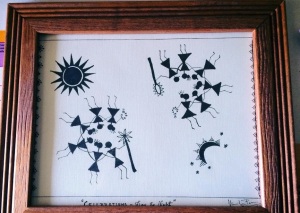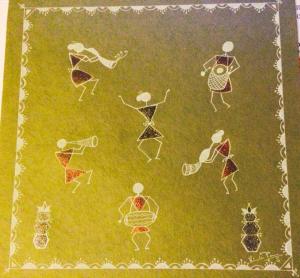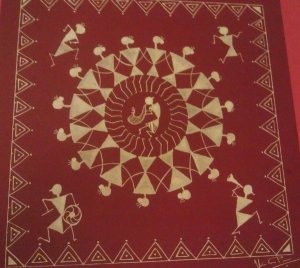I started learning Warli paintings because of the sheer simplicity and the curiosity to find out more about the culture and tradition embedded within this wonderful form of art. Art is not just about creativity, it is also about re-inventing the history, it is also about depicting a certain way of life, it is also about culture and simplicity. I got fascinated by the wall paintings. I was more attracted to this form of painting because of the simplicity in it.
Warli paintings are the tribal wall paintings of the warli tribes of Maharashtra. Warlis are the largest tribes of Maharashtra live in northern outskirts of Mumbai. Womenfolks mainly do the paintings on the mud walls of the houses.Warli paintings generally depict the normal life like images of human beings and animals, along with scenes from daily life. They also depict hunting, dancing, sowing and harvesting scenes. White is the only colour used in creating these paintings, with occasional dots in red and yellow. This colour is prepared by grounding rice into white powder.
Warli is the name of a tribe, which resides in Thane district of Maharashtra on the northern outskirts of Mumbai and extends up to the Gujarat border. They are spread out in the villages named Dahanu, Vada, Talasari, Palghar, Mokhada and several other parts of the district as well. The origin of the warlis is yet unknown and no records of this art are found, but many scholars and folklorists believe that it can be traced to as early as tenth century A.D when man learnt to build walls of the house. The Warli Art (Warli Painting) was eventually discovered in the early seventies, and became popular for its unique simplicity and fervor for life.
The warlis were originally hunters but today they are farmers and work according to the monsoon. Thus their paintings are also influenced by the seasonal cycle as their life around them is directly reflected in the paintings.To understand and enjoy the paintings of Warlis, one should know their religion, their rituals and see life from their perspective. As the life of warlis link closely with nature, they worship the nature in different forms – Sun and moon, god of thunder, lightning, wind, rain, and several others. Gods are worshiped according to the seasons. In the coming of the first rice they worship the god of rain and it’s called the festival of Naranadeva. This is then followed by the worship of household gods, in the festival of Hirva, Warli paintings have various subjects or themes, which depict a story from their daily activities. Each painting has numerous elements giving a panoramic view. The subjects found in these paintings are various animals, trees, women, children, men, group of men dancing around a person playing the music, wedding scenes, descriptive harvest scene, birds, dancing peacocks, etc.
The paintings are also based on celebrations of Gods – Himai, Jhoting,Naranadeva,Tiger God, festival of Kansari- the goddess of grain and the deity of fertility, Palghata, is worshipped (during marriage ceremony). For the Warlis, life is cyclic repeating it eternally. Circles best represent the art of warli, which has neither an end nor a beginning. At all occasions – birth, marriage, and death they draw circles, symbol of Mother goddess. Death is not the end for them; rather it is a new beginning.
A few of the paintings that I have made in Warli style:
Painting W_01, symbolizes the celebration of day and night. The dancers are performing dance and celebrating the day to day life of bliss and prosperity. 
Painting W_02, is about the celebration of music.
Painting W_03, Dancers in a circle.
Look forward to many more……….

